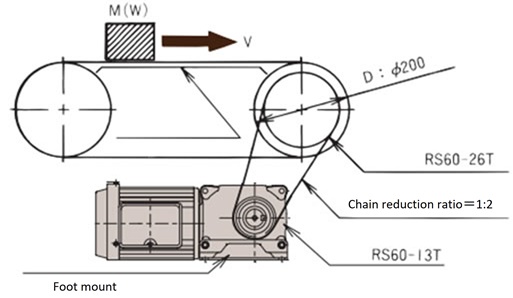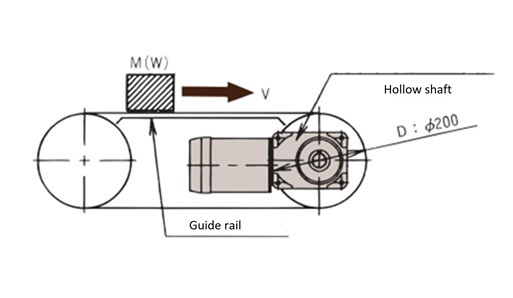Technical Data Reducers Small-Size Gear Motor Selection
To view selection procedures and precautions, please proceed to the following.
Click here to narrow down the product series or to make a tentative selection.
If you have specific conditions of use and wish to make a detailed selection, please click here.
Selection example [Conveyor drive ]
The figures below show installation methods for foot mount and hollow shaft mount for hypoid motors.
For gear motors and croise motors, select the appropriate installation method.
A:Foot mount

|
B:Hollow shaft mount

|
|
Selection criteria
|
|
1. Determination of reduction ratio
Determine the reduction ratio based on the necessary revolution speed of the output shaft.
Select the reduction ratio by referring to the specification chart.
- A:(1) Calculate the revolution speed (nC) of the conveyor shaft.
nC = V × 1000 D × π = 14 × 1000 200 × π = 22.3 r/min
- (2) Calculate the revolution speed (nL) of the hypoid motor output shaft.
nL = nC × 2 1 = 44.6 r/min
- (3)Determine the reduction ratio.
According to the specification chart on the product page, an output shaft revolution speed of 45 r/min is closest to 60 Hz, 44.6 r/min. Therefore the suitable reduction ratio is 1/40.
- B:(1) Calculate the revolution speed (nC) of the conveyor shaft.
nC = V × 1000 D × π = 14 × 1000 200 × π = 22.3 r/min
- (2) Calculate the revolution speed (nL) of the hypoid motor output shaft.
nL = nC = 22.3 r/min
- (3)Determine the reduction ratio.
According to the specification chart on the product page, an output shaft revolution speed of 22.5 r/min is closest to 60 Hz, 22.3 r/min. Therefore the suitable reduction ratio is 1/80.
2. Calculation of output shaft torque
Calculate the necessary output shaft torque based on the load torque.
To calculate the corrected torque of the output shaft, use Table 1 on to choose a service factor to multiply that matches the operating conditions.
- A:(1) Calculate the necessary torque (TC) of the conveyor shaft.
TC = 9.8μM D 2 × 1 1000 × 1 η = 9.8 × 0.15 × 150 × 200 2000 × 1 0.95 = 23.2N・m
TC = μW D 2 × 1 1000 × 1 η = 0.15 × 150 × 200 2000 × 1 0.95 = 2.37kgf・m
- (2) Calculate the hypoid motor output shaft torque (TL) based on the conveyor shaft torque.
TL = TC × 1 2 × 1 η = 23.2 × 1 2 × 1 0.95 = 12.2N・m
TL = TC × 1 2 × 1 η = 2.37 × 1 2 × 1 0.95 = 1.25kgf・m
- (3) Calculate the corrected torque (TF) of the output shaft.
service factor CF = 1, TF = TL × 1 = 12.2N・m
{TF = TL × 1 = 1.25kgf・m} - (4) Determine the motor capacity.
According to the specification charts on the product page, the motor capacity suitable for "Reduction ratio: 1/40, 60 Hz, Torque: 12.2 N・m {1.25kgf・m}" is 0.1 kW.
- B:(1) Calculate the necessary torque (TC) of the conveyor shaft.
TC = 9.8μM D 2 × 1 1000 = 9.8 × 0.15 × 150 × 200 2000 = 22.1N・m
TC = μW D 2 × 1 1000 = 0.15 × 150 × 200 2000 = 2.25kgf・m
- (2) Because the hypoid motor output shaft torque (TL) is equal to the conveyor shaft torque, TL = TC = 22.1 N・m {TL = TC = 2.25 kgf・m}
- (3) Calculate the corrected torque (TF) of the output shaft.
service factor CF = 1, TF = TL × 1 = 22.1N・m {TF = TL × 1 = 2.25kgf・m}
- (4) Determine the motor capacity.
According to the specification charts on the product page, the motor capacity suitable for "Reduction ratio: 1/80, 60 Hz, Torque: 22.1 N・m {2.25kgf・m}" is 0.1 kW.
3. Tentative determination of model number
Keep in mind the reduction ratio, torque, and immediate stopping when performing the following.
A:Tentatively select A: brake-type hypoid motor HMTA010-22L40RB and confirm the conditions.
B:Tentatively select B: brake-type hypoid motor HMTA010-20H80B and confirm the conditions.
4. Confirmation of moment of inertia of load {load inertia (GD2)} and starting frequency
When starting a motor with a large moment of inertia of the load (also when stopping, for brake-equipped models), a large torque is generated momentarily and this may cause an accident. Check the coupling method of the load and the moment of inertia [inertia load (GD2)] of the load.
- A:(1) Calculate the moment of inertia of the load on the conveyor shaft (IC) {Load inertia (GDC2)}.
IC = MR2 = 150 × 0.12 = 1.5kg・m2
{GDC2 = WD2 = 150 × 0.22 = 6kgf・m2}R = 1 2 D
- (2) Calculate the moment of inertia (Iℓ){load inertia (GDℓ2)} on the motor shaft.
Iℓ = IC × 1 iC2 × 1 iL2 = 1.5 × 1 2 2 × 1 40 2 = 0.23 × 10-3kg・m2
GDℓ2 = GDC2 × 1 iC2 × 1 iL2 = 6 × 1 2 2 × 1 40 2 = 0.94 × 10-3kgf・m2
- (3) Calculate the inertia ratio (U) for the hypoid motor.
U = Iℓ IM
U = GDℓ2 GDM2
The moment of inertia (IM) {load inertia (GDM2)} on the motor shaft is 0.66×10-3kg・m2 {2.64×10-3kgf・m2}
U = 0.23 × 10-3 0.66 × 10-3 ≒ 0.35
U = 0.94 × 10-3 2.64 × 10-3 ≒ 0.36
- (4) Checking the starting frequency
According to Table 3 Inertia ratio and allowable starting frequency, the starting frequency is 30 times/hour, which satisfies the conditions.
- B:(1) Calculate the moment of inertia of the load on the conveyor shaft (IC) {Load inertia (GDC2)}.
IC = MR2 = 150 × 0.12 = 1.5kg・m2
{GDC2 = WD2 = 150 × 0.22 = 6kgf・m2}R = 1 2 D
- (2) Calculate the moment of inertia (Iℓ)(GDℓ2) on the motor shaft.
Iℓ = IC × 1 iL2 = 1.5 × 1 80 2 = 0.23 × 10-3kg・m2
GDℓ2 = GDC2 × 1 iL2 = 6 × 1 80 2 = 0.94 × 10-3kgf・m2
- (3) Calculate the inertia ratio (U) for the hypoid motor.
U = Iℓ IM
U = GDℓ2 GDM2
The moment of inertia (IM) on the motor shaft is 0.66×10-3kg・m2 {2.64×10-33kgf・m2}
U = 0.23 × 10-3 0.66 × 10-3 ≒ 0.35
U= 0.94 × 10-3 2.64 × 10-3 ≒ 0.36
- (4) Checking the starting frequency
According to Table 3 Inertia ratio and allowable starting frequency, the starting frequency is 6 times/hour, which satisfies the conditions.
※If the allowable starting frequency does not satisfy the conditions, the reducer may become damaged, and it will not last its expected life span. Choose a higher model number and recheck the starting frequency; or, lower the frequency of usage.
- ・If you cannot lower the frequency of usage, the product will have a shorter life span. Please contact Tsubaki.
- ・When the inertia ratio is large, we recommend a slow start using an inverter.
5. Confirmation of overhang load (O.H.L.)
When attaching a sprocket, gear, or belt to the output shaft or the input shaft, check that the overhang load acting on the shaft is equal to or less than the allowable overhang load of the hypoid motor (shown in the specification chart).
Calculate the O.H.L.
O.H.L = 2000TF × f × Lf DS
- A:Assuming that the load acts on the midpoint of the length of the shaft, use Table 4 and Formula 1, and Table 5,
f = 1 Lf = 1
RS60-13T P.C.D = 79.6 mm and
O.H.L = 2000 × 12.2 × 1 × 1 79.6 = 307N
O.H.L = 2000 × 1.25 × 1 × 1 79.6 = 31.4kgf
so the O.H.L. calculated above is within this range. The allowable O.H.L. on the specification chart is 1617N [165 kgf],
- B:Assuming that the load acts on a position at ℓ from the hollow output shaft end,
f = 1 Lf = 1
O.H.L = 2000 × 22.1 × 1 × 1 200 = 221N
O.H.L = 2000 × 2.25 × 1 × 1 200 = 22.5kgf
so the O.H.L. calculated above is within this range. The allowable O.H.L. on the specification chart is 2254N [230 kgf],
※If the calculated O.H.L. exceeds the allowable O.H.L., shift the load acting position toward the base of the output shaft, use a sprocket with longer P.C.D., or select a larger hypoid motor.
6. Determination of model No.
The following model numbers have been selected as satisfying conditions for safe installation, power supply, immediate stopping, torque, reduction ratio, starting frequency, and O.H.L.
Brake-type hypoid motor
A:HMTA010-22L40RB
B:HMTA010-20H80B

